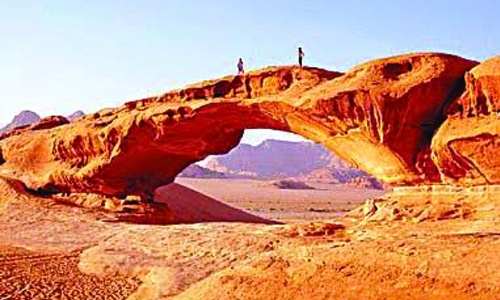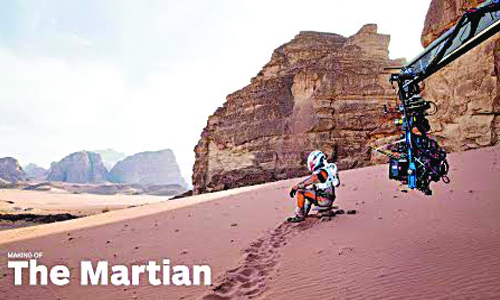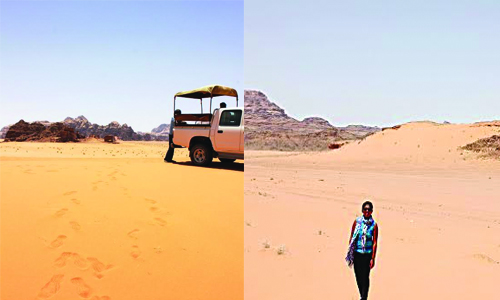Wadi Rum – Mars on Earth?
Undoubtedly, this is one of the most sought after places in Jordan, but having lived and travelled across the Middle East, I wasn’t exactly too excited to see Wadi Rum. So I just waited to see what it actually beholds in reality without reading or researching too much before hand, which in retrospect was what made it worth the while for me.
Driving one and a half hours from Petra to Wadi Rum, our driver told us that it’s the largest sandy desert in the country spanning several acres from Jordan, up and into Saudi Arabia. What I enjoyed most was how gradually I could see, feel and experience the entire atmosphere and surroundings change during this ride. I distinctly remember turning left from the King’s Way (ancient caravan route and present highway in Jordan) into a road leading into the valley, where on either side lay watermelon farms, small houses, railway tracks and then all of a sudden we parked in front of our camp that was all encompassed by red sand, mighty sandstone mountains and tranquility!
The entire desert is believed to have been submerged under water 10,000 years ago and with time, natural calamities, erosion and age gave rise to the landscape. What makes the valley (wadi in Arabic) so special are the hundreds of beautiful sandstone and granite rock formations, its expansive area that has majorly uninhabited except for the Bedouins and the red colour of sand itself. YES, this IS the place where Matt Damon shot the Martian last year!
I hadn’t known this until we reached the exact spot where the scene was shot when our jeep driver a local Bedouin casually said how many movies were shot in that particular place as the red sand and its texture made for perfect shots in a director’s eyes. In fact, Lawrence of Arabia (1962) was the movie that put Wadi Rum on the big screen, a story based on the real life of British officer T. E. Lawrence (Lawrence of Arabia) who based his operations here during the Arab Revolt of 1917–18. Lawrence used Wadi Rum as a base to camp away from the ottoman eyes and to meet with the local Bedouins in the region to arrange a joined attack to capture Aqaba.
The silk route or caravan route used to pass through this iconic desert and proving this you can find several drawings and inscriptions on the rocks which 4000 years old but still intact.
There are several trails, tours and ways to explore the valley like a short two hour jeep tour, camel rides, hikes and much more. Each presents a different view and experience. There more than camps – some 5-star and one even with a ridiculous swimming pool in the middle of the desert – where you can spend the night in the valley, immerse yourself in local Bedouin art, music and culture while reveling in the one-of-a-kind sunset and starry skies. Due to time constraints I was only able to take a jeep tour of Wadi Rum, but I would strongly recommend staying back and getting the full experience.
“Vast, echoing and God-like” is what Lawrence is believed to have called this natural wonder and it surely lives up to those words in every way!
Shreya Vaidyanathan is an alumnus of the Indian School Bahrain who currently pursues her studies in the College of engineering, Guindy in Chennai. She is a travel enthusiast, ever eager to explore new places, experience different cultures, traditions and meet new people to see how others love, laugh or live on this planet.
You can read more of her travelogues at https://traveltreasurer.wordpress.com/about/
Related Posts




